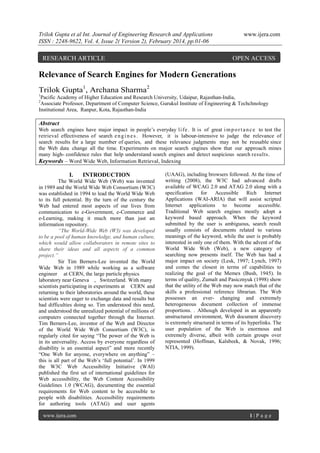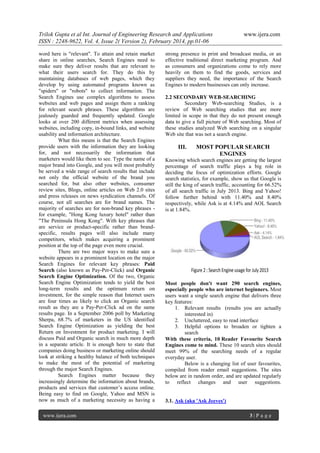The document discusses the significant impact of web search engines on modern society, emphasizing their role in information retrieval and user experience. It highlights both primary and secondary research studies on search engines, revealing challenges in evaluating the relevance of search results. The effectiveness of search engines and their algorithms in delivering relevant content is deemed crucial for users and businesses alike.




![Trilok Gupta et al Int. Journal of Engineering Research and Applications
ISSN : 2248-9622, Vol. 4, Issue 2( Version 2), February 2014, pp.01-06
Mahalo also offers regular web searching in addition
to asking questions. Depending on which of the two
search boxes you use at Mahalo, you will either get
direct content topic hits or suggested answers to your
question.
Try Mahalo. You might like it enough to even
become a editor there.
search engines. By indexing a target Web page more
accurately, and allowing each user to perform more
fine-grained search that satisfy his/her information
need.
REFERENCES
[1]
3.9. Yahoo!
Yahoo! is several things: it is a search
engine, a news aggregator, a shopping center, an
emailbox, a travel directory, a horoscope and games
center, and more. This 'web portal' breadth of choice
makes this a very helpful site for Internet beginners.
Searching the Web should also be about discovery
and exploration, and Yahoo! delivers that in
wholesale quantities.
[2]
[3]
[4]
3.10. Google
[5]
Google is the undisputed king of 'spartan
searching'. While it doesn't offer all the shopping
center features of Yahoo!, Google is fast, relevant,
and the largest single catalogue of Web pages
available today. Make sure you try the Google
'images', 'maps' and 'news' features... they are
outstanding services for locating photos, geographic
directions, and news headlines.
[6]
[7]
[8]
[9]
Top 5 Search Engines by Total Visits
Week ending August 24, 2013
Web
sites
Total Visits
Visits Rank Rank Rank
Share 08/17 08/10 08/03
Google
2,468,944,85
67.26%
6
1
1
1
Bing
401,735,522 10.94%
2
2
301,801,156 8.22%
3
3
3
Ask
151,567,463 4.13%
4
4
[10]
2
Yahoo!
Search
4
AOL
62,010,716 1.69%
5
5
Search
Source: Hitwise US
© 2013 Hitwise Pty Ltd. All rights reserved.
IV.
www.ijera.com
[11]
5
[12]
CONCLUSION
Successful searching of information on the
internet depends on techniques such as going straight
to the information source, guess work and developing
strategies for when to use subject directories and
[13] 2002.
www.ijera.com
[14]
R. Baeza-Yates, F. Saint-Jean, and C.
Castillo. Web Structure, Dynamics and
Page Quality. In Proc. of the 9th
International
Symposium
on
String
Processing and Information Retrieval
(SPIRE 2002), pages 117–130, 2002.
Henzinger et. al. “ Challenges in web search
engine.”ACM SIGIR Forum, 2002 dl.acm.org.
Abhishek Das, Ankit Jain “Indexing the
World Wide Web : The Journey So
Far.”Publisher: IGI Global, Pages: 1-24.
Monika R.Henzinger“Algorithmic in Web
Search Engines”
Internet Mathematics
Vol.1, No.1:115-126.
K. Sugiyama. A
Method
of
Reranking Search Results Using their
Hidden Hyperlink Structure.
In
Doctoral Posters Program of 28th
International Conference on Very Large
Data
Bases
(VLDB2002),
http://www.cs.ust.hk/vldb2002/VLDB2002proceedings/papers/S34P14.pdf, 2002.
http://www.webopedia.com.
http://www.google.com.
http://docs.google.com.
Rainer Olbrich, Carsten D. Schultz “Search
Engine Marketing and Click Fraud”
Business Information
Review
(2003)
Volume: 20, Issue: 4, Pages: 195-202
ISSN:
02663821
DOI:
10.1177/0266382103204005
TamarSadeh
“User centric solutions for
scholarly research in the library.” LIBER
QUARTERLY, ISSN 1435-5205 © LIBER
2007. All rights reservedIgitur. Utrecht
Publishing & Archiving Services.
Jansex et. al. “Determining the user intent of
web search engine queries.” WWW '07
Proceedings of the 16th international
conference on World Wide Web ACM New
York, NY, USA ©2007 table of contents
ISBN: 978-1-59593-654-7.
J. Wang, Z. Chen, L. Tao, W.-Y. Ma and
L. Wenyin. Ranking User‟s Relevance to a
Topic through Link Analysis on Web Logs.
In Proc. of the 4th ACM CIKM International
Workshop on Web Information and Data
Management (WIDM‟02), pages 49–54,
Monika
Hezinger,
Jeffrey
Beall
“The
5|P age](https://image.slidesharecdn.com/a42020106-140304032004-phpapp02/85/A42020106-5-320.jpg)
![Trilok Gupta et al Int. Journal of Engineering Research and Applications
ISSN : 2248-9622, Vol. 4, Issue 2( Version 2), February 2014, pp.01-06
[15]
[16]
solution to weaknesses of web search
engine” Science Publishing Online august
2007.
www.cloaking.com.
Prof. Dr. Andreas Meier “Meta Search
Engine Analysis”University of Fribourg
Faculty of Economics Social Sciences
Information Systems Research Group MetaSearch Engine Analysis Seminar Thesis
September 2010.
Author’s Profile
Trilok Gupta was born in Kota
(Rajasthan). He received his Master Degree in
Computer Science from Janardan Rai Nagar
Rajasthan
Vidhyapeeth
University,
Udaipur,
Rajasthan -India. He is pursuing Ph.D. Computer
Science from Faculty of Computer Application,
Pacific University Udaipur-PAHER, Rajasthan India. His area of interest includes Web Applications,
Search Engines and Information Exploring.
www.ijera.com
www.ijera.com
Archana Sharma was born in Ajmer
(Rajasthan). She is Ph.D in Computer Science and
Engineering with specialization in Simulation and
Modeling. She completed her M.Tech in Computer
Science from Banasthali Vidyapith, India. Her field
of study is Simulation and modeling, data mining,
database, Artificial Intelligence.
She is working in the field of education for
last 15 years. She has taught many subjects at
undergraduate and postgraduate level. She has
published several research papers in national and
International Journals. She is currently working in the
field of Cloud Computing, Artificial Intelligence and
Educational Data Mining. She is Senior Member of
International Association of Computer Science and
Information Technology (IACSIT). She is also the
Board member in Seventh Sense Research Group
Journals.
Professor Sharma is member of Indian
Society of Theoretical and Applied Mechanics. She
worked as Editor in Journal of Management and IT
„OORJA‟.
6|P age](https://image.slidesharecdn.com/a42020106-140304032004-phpapp02/85/A42020106-6-320.jpg)